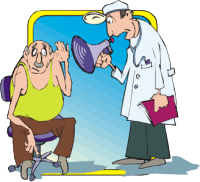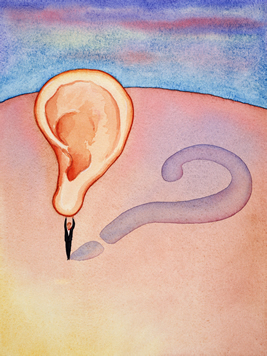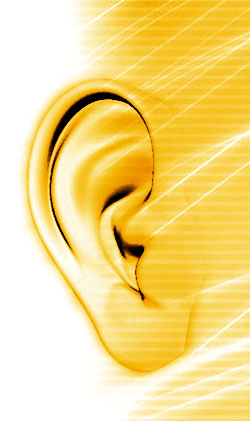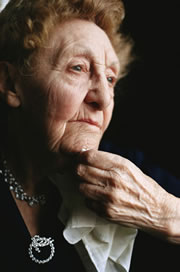Audiology
DOES THIS SOUND FAMILIAR?
Every evening when Mrs. Sprout and her husband watch television
together she repeatedly asks him to turn up the volume. Recently,
her friends have noticed that she often asks them to repeat
what they have said, and sometimes she answers their questions
inappropriately as if she is not even following the conversation.
When Mrs. Jones goes to bed at night, she is aware of a ringing
in her ears that makes it difficult to go to sleep.
Unfortunately, situations like Mrs. Sprouts' are all too
common. More than 20 million Americans suffer some form of
hearing impairment, many unaware that they may be helped.
Diagnostic Testing:
Audiometric Evaluations
Using specialized equipment in our two test booths, our audiologist
can determine the ability to hear and discriminate sounds.
A hearing evaluation includes a variety of subtests that can
indicate the severity and type of hearing loss. Usually a
hearing test will include evaluating the ability to understand
speech. The Auditory Brainstem Response (ABR) is a painless
electrode test used to evaluate the auditory system. With
the ABR technology no one is too young or too old to have
a hearing test.
Tests for Balance Disorders
The ear works with the eyes and spine to control balance.
However, balance disorders may occur with or without a loss
of hearing. Electronystagmography (ENG) testing uses electrodes
placed on the head to record eye movements as the patient
looks at various patterns and moves the head to different
positions. The temperature of the ear canal is also changed
to stimulate the inner ear, and eye movements are charted.
ENG results are interpreted by physicians to help diagnose
the cause of dizziness so that appropriate treatment can be
implemented.
Facts about Otosclerosis
What is otosclerosis?
The term otosclerosis is derived from the Greek words for
"hard" (scler-o) and "ear" (oto). It describes
a condition of abnormal growth in the tiny bones of the middle
ear, which leads to a fixation of the stapes bone. The stapes
bone must move freely for the ear to work properly and hear
well.
Hearing is a complex process. In a normal ear, sound vibrations
are funneled by the outer ear into the ear canal where they
hit the ear drum. These vibrations cause movement of the ear
drum that transfers to the three small bones of the middle
ear, the malleus (hammer), incus (anvil), and stapes (stirrup).
When the stapes bone moves, it sets the inner ear fluids in
motion, which, in turn, start the process to stimulate the
auditory (hearing) nerve. The hearing nerve then carries sound
energy to the brain, resulting in hearing of sound. When any
part of this process is compromised, hearing is impaired.
Who gets otosclerosis and why?
It is estimated that ten percent of the adult Caucasian population
is affected by otosclerosis. The condition is less common
in people of Japanese and South American decent and is rare
in African Americans. Overall, Caucasian, middle-aged women
are most at risk.
The hallmark symptom of otosclerosis, slowly progressing
hearing loss, can begin anytime between the ages of 15 and
45, but it usually starts in the early 20’s. The disease
can develop in both women and men, but is particularly troublesome
for pregnant women who, for unknown reasons, often experience
a rapid decrease in hearing ability.
Approximately 60 percent of otosclerosis cases are genetic
in origin. On average, a person who has one parent with otosclerosis
has a 25 percent chance of developing the disorder. If both
parents have otosclerosis, the risk goes up to 50 percent.
What are the symptoms?
Gradual hearing loss is the most frequent symptom of otosclerosis.
Often, individuals with otosclerosis will first notice that
they cannot hear low-pitched sounds or whispers. Other symptoms
of the disorder can include dizziness, balance problems, or
a sensation of ringing, roaring, buzzing, or hissing in the
ears or head known as tinnitus.
How is it diagnosed?
Because many of the symptoms typical of otosclerosis can
also be caused by other medical conditions, it is important
to be examined by an otolaryngologist (ear, nose and throat
doctor) to eliminate other possible causes of the symptoms.
After an ear exam, the otolaryngologist may order a hearing
test. Based on the results of this test and the exam findings,
the otolaryngologist will suggest treatment options.
How is it treated?
If the hearing loss is mild, the otolaryngologist may suggest
continued observation and a hearing aid to amplify the sound
reaching the ear drum. Sodium fluoride has been found to slow
the progression of the disease and may also be prescribed.
In most cases of otosclerosis, a surgical procedure called
stapedectomy is the most effective method of restoring or
improving hearing.
What is a stapedectomy?
A stapedectomy is an outpatient surgical procedure done under
local or general anesthesia through the ear canal with an
operating microscope. (No outer incisions are made.) It involves
removing the immobilized stapes bone and replacing it with
a prosthetic device. The prosthetic device allows the bones
of the middle ear to resume movement, which stimulates fluid
in the inner ear and improves or restores hearing.
Modern-day stapedectomies have been performed since 1956
with a success rate of 90 percent. In rare cases (about one
percent of surgeries), the procedure may worsen hearing.
Otosclerosis affects both ears in eight out of ten patients.
For these patients, ears are operated on one at a time; the
worst hearing ear first.
What should I expect after a stapedectomy?
Most patients return home the evening after surgery and are
told to lie quietly on the un-operated ear. Oral antibiotics
may be prescribed by the otolaryngologist. Some patients experience
dizziness the first few days after surgery. Taste sensation
may also be altered for several weeks or months following
surgery, but usually returns to normal.
Following surgery, patients may be asked to refrain from
nose blowing, swimming, or other activities that may get water
in the operated ear. Normal activities (including air travel)
are usually resumed two weeks after surgery.
Notify your otolaryngologist immediately if any of the following
occurs:
- Sudden hearing loss
- Intense pain
- Prolonged or intense dizziness
- Any new symptom related to the operated ear
Since packing is placed in the ear at the time of surgery,
hearing improvement will not be noticed until it is removed
about a week after surgery. The ear drum will heal quickly,
generally reaching the maximum level of improvement within
two weeks.
Your Genes and Hearing Loss 
Your Genes and Hearing Loss
One of the most common birth defects is hearing loss or deafness
(congenital), which can affect as many as three of every 1,000
babies born. Inherited genetic defects play an important role
in congenital hearing loss, contributing to about 60 percent
of deafness occurring in infants. Although exact data is not
available, it is likely that genetics plays an important role
in hearing loss in the elderly. Inherited genetic defects
are just one factor that can lead to hearing loss and deafness,
both of which may occur at any stage of a person’s lifespan.
Other factors may include: medical problems, environmental
exposure, trauma, and medications.
The most common and useful distinction in hearing impairment
is syndromic versus non-syndromic.
- Non-syndromic hearing impairment accounts for the vast
majority of inherited hearing loss, approximately 70 percent.
Autosomal- recessive inheritance is responsible for about
80 percent of cases of non-syndromic hearing impairment,
while autosomal-dominant genes cause 20 percent, less than
two percent of cases are caused by X-linked and mitochondrial
genetic malfunctions.
- Syndromic(sin-DRO-mik) means that the hearing impairment
is associated with other clinical abnormalities. Among hereditary
hearing impairments, 15 to 30 percent are syndromic. Over
400 syndromes are known to include hearing impairment and
can be classified as: syndromes due to cyotgenetic or chromosomal
anomalies, syndromes transmitted in classical monogenic
or Mendelian inheritance, or syndromes due to multi-factorial
influences, and finally, syndromes due to a combination
of genetic and environmental factors.
Variable expression of different aspects of syndromes is common.
Some aspects may be expressed in a range from mild to severe
or different combinations of associated symptoms may be expressed
in different individuals carrying the same mutation within
a single pedigree. An example of variable expressivity is
seen in families transmitting autosomal dominant Waardenburg
syndrome. Within the same family, some affected members may
have dystopia canthorum (an unusually wide nasal bridge due
to sideways displacement of the inner angles of the eyes),
white forelock, heterochromia irides (two different-colored
irises or two colors in the same iris), and hearing loss,
while others with the same mutation may only have dystopia
canthorum.
How do genes work?
Genes are a road map for the synthesis of proteins, which
are the building blocks for everything in the body: hair,
eyes, ears, heart, lung, etc. Every child inherits half of
its genes from one parent and half from the other parent.
If the inherited genes are defective, a health disorder such
as hearing loss or deafness can result. Hearing disorders
are inherited in one of four ways:
Autosomal Dominant Inheritance: For autosomal
dominant disorders, the transmission of a rare allele of a
gene by a single heterozygous parent is sufficient to generate
an affected child. A heterozygous parent has two types of
the same gene (in this case, one mutated and the other normal)
and can produce two types of gametes (reproductive cells).
One gamete will carry the mutant form of the gene of interest,
and the other the normal form. Each of these gametes then
has an equal chance of being used to form the offspring. Thus
the chance that the offspring of a parent with an autosomal
dominant gene will develop the disorder is 50 percent. Autosomal
dominant traits usually affect males and females equally.
Autosomal Recessive Inheritance: An autosomal recessive
trait is characterized by having parents who are heterozygous
carriers for mutant forms of the gene in question but are
not affected by the disorder. The problem gene that would
cause the disorder is suppressed by the normal gene. These
heterozygous parents (A/a) can each generate two types of
gametes, one carrying the mutant copy of the gene (a) and
the other having a normal copy of the gene (A). There are
four possible combinations from each of the parents, A/a,
A/A, a/A, and a/a. Only the offspring that inherits both mutant
copies (a/a) will exhibit the trait. Overall, offspring of
these two parents will face a 25 percent chance of inheriting
the disorder.
X-linked Inheritance: A male offspring has
an X chromosome and a Y chromosome, while a female has two
copies of the X chromosome only. Each female inherits an X
chromosome from her mother and her father. On the other hand,
each male inherits an X chromosome from his mother and a Y
chromosome from his father. In general, only one of the two
X chromosomes carried by a female is active in any one cell
while the other is rendered inactive. This is why when a female
inherits a defective gene on one X chromosome, the normal
gene on the other X chromosome can usually compensate. As
males only have one copy of the X chromosome, any defective
gene is more likely to manifest into a disorder.
Mitochondrial Inheritance: Mitochondrias,
small powerhouses within each cell, also contain their own
DNA. Interestingly, the sperm does not have any mitochondria,
and consequently, only the mitochondria in the egg from the
mother can be passed from one generation to the next. This
leads to an interesting inheritance pattern where only affected
mothers (and not affected fathers as their sperms do not have
mitochondria) can pass on a disease from one generation to
the next. Sensitivity to aminoglycoside antibiotics can be
inherited through a defect in mitochondrial DNA and is the
most common cause of deafness in China!
In the last decade, advances in molecular biology and genetics
have contributed substantially to the understanding of development,
function, and pathology of the inner ear. Researchers have
identified several of the various genes responsible for hereditary
deafness or hearing loss, most notably the GJB2 gene mutation.
As one of the most common genetic causes of hearing loss,
GJB2-related hearing loss is considered a recessive genetic
disorder because the mutations only cause deafness in individuals
who inherit two copies of the mutated gene, one from each
parent. A person with one mutated copy and one normal copy
is a carrier but is not deaf. Screening tests for the GJB2
gene are available for at risk individuals to help them determine
their risk of having a child with hearing problems.
© 2004 AAO-HNS/AAO-HNSF
Hearing Aids Through the Ages
Hearing aids in their various forms have provided needed
amplification of sound for many persons experiencing hearing
loss. Explore the virtual
exhibit.
© 2004 AAO-HNS/AAO-HNSF
Buying a Hearing Aid
Answers to common questions
I don't hear well. What should I do? What should I expect?
Because some hearing problems can be medically corrected,
first visit a physician who can refer you to an otolaryngologist
(an ear, nose, and throat specialist). If you have ear pain,
drainage, excess earwax, hearing loss in only one ear, sudden
or rapidly progressive hearing loss, or dizziness, it is especially
important that you see an otolaryngologist. Then, get a hearing
assessment from an audiologist (a nonphysician health care
professional). A screening test from a hearing aid dealer
may not be adequate. Many otolaryngologists have an audiologist
associate in their office who will assess your ability to
hear pure tone sounds and to understand words. The results
of these tests will show the degree of hearing loss and whether
it is conductive or sensorineural and may give other medical
information about your ears and your health.
Where do I go to get hearing aids?
Because federal regulation prohibits any hearing aid sale
unless the buyer has first received a medical evaluation from
a physician, you will need to see your physician before you
purchase a hearing aid(s). However, the regulation says that
if you are more than 18 years old and are aware of the recommendation
to receive a medical exam, you may sign a waiver to forego
the exam. An otolaryngologist, audiologist, or an independent
dispenser can dispense aids. Hearing aids should be custom
fitted to your ear and hearing needs. Hearing aids purchased
by mail-order typically cannot be custom fitted.
Conductive Hearing Loss
A hearing loss is conductive when there is a problem with
the ear canal, the eardrum and/or the three bones connected
to the eardrum. Common reasons for this type of hearing loss
are a plug of excess wax in the ear canal or fluid behind
the eardrum. Medical treatment or surgery may be available
for these and more complex forms of conductive hearing loss.
Sensorineural Hearing Loss
A hearing loss is sensorineural when it results from damage
to the inner ear (cochlea) or auditory nerve, often as a result
of the aging process and/or noise exposure. Sounds may be
unclear and/or too soft. Sensitivity to loud sounds may occur.
Medical or surgical intervention cannot correct most sensorineural
hearing losses. However, hearing aids may help you reclaim
some sounds that you are missing as a result of nerve deafness.
How expensive are hearing aids?
Hearing aids vary in price according to style, electronic
features, and local market conditions. Price can range from
many hundreds of dollars to more than $2,500 for a programmable,
digitalized hearing aid. Purchase price should not be the
only consideration in buying a hearing aid. Product reliability
can save repair costs and the frustration of a malfunctioning
hearing aid.
What kinds of hearing aids are available?
There are several styles of hearing aids:
- Behind-the-ear (BTE) hearing aids are placed over the
ear and connected with tubing to custom-fitted earpieces.
- In-the-ear (ITE) hearing aids fill the entire bowl of
the ear and part of the ear canal.
- Smaller versions of ITEs are called half-shell and in-the-canal
(ITC).
- The least visible aids are completely-in-the-canal (CIC).
Hearing aid options, which are appropriate for your particular
hearing loss and listening needs, the size, and shape of your
ear and ear canal, and the dexterity of your hands will all
be considered in deciding what type of hearing aid is the
best for you. Many hearing aids have special telecoil "T"
switches to aid in use of the telephone and certain public
sound systems. Discuss your need for a T-coil switch while
you are considering hearing aid options.
Will I need a hearing aid for each ear?
Usually, if you have hearing loss in both ears, using two
hearing aids is best. Listening in a noisy environment is
difficult with amplification in one ear only, and it is more
difficult to distinguish where sounds are coming from. If,
however, the quality of hearing in one ear is very different
from the other, one hearing aid may be better than two.
What other questions should I ask?
- Ask about charges for the hearing evaluation, dispensing
fee(s), and future servicing and repair.
- Inquire about the trial period policy and what fees are
refundable if you return the hearing aid(s) during the trial
period.
- Ask about the warranty coverage for your hearing aids
and the consumers' protection program for hearing aid purchasers
in your state.
What will happen at my hearing aid fitting?
- The hearing aids will be fitted for your ears.
- Then, while wearing your hearing aids, you will be tested
for word understanding in quiet and in noise and for improvement
in hearing tones.
- Next, you will receive instruction about the care of
your hearing aids, the batteries used to power them, a suggested
wearing schedule, general expectations, and helpful communication
strategies.
- You will also practice properly inserting and removing
the hearing aids and batteries.
How should I begin wearing the aids?
- Start using your hearing aids in quiet surroundings, gradually
building up to noisier environments.
- Note where and when that you find the hearing aids beneficial.
- Be patient and allow yourself to get used to the aids
and the "new" sounds they allow you to hear.
- Keep a diary to help you remember your experiences.
- Report any concerns on a follow-up appointment.
© 2004 AAO-HNS/AAO-HNSF
Doctor, What Causes Tinnitus? 
I sometimes hear ringing in my ears. Is this unusual?
Not at all. Tinnitus is the name for these head noises, and
they are very common. Nearly 36 million Americans suffer from
this discomfort. Tinnitus may come and go, or you may be aware
of a continuous sound. It can vary in pitch from a low roar
to a high squeal or whine, and you may hear it in one or both
ears. When the ringing is constant, it can be annoying and
distracting. More than seven million people are afflicted
so severely that they cannot lead normal lives.
Can other people hear the noise in my ears?
Not usually, but sometimes they are able to hear a certain
type of tinnitus. This is called "objective tinnitus,"
and it caused either by abnormalities in blood vessels around
the outside of the ear or by muscle spasms, which may sound
like clicks or crackling inside the middle ear.
What causes tinnitus?
Most tinnitus comes from damage to the microscopic endings
of the hearing nerve in the inner ear. The health of these
nerve endings is important for acute hearing, and injury to
them brings on hearing loss and often tinnitus. If you are
older, advancing age is generally accompanied by a certain
amount of hearing nerve impairment and tinnitus. If you are
younger, exposure to loud noise is probably the leading cause
of tinnitus, and often damages hearing as well.
There are many causes for "subjective tinnitus,"
the noise only you can hear. Some causes are not serious (a
small plug of wax in the ear canal might cause temporary tinnitus).
Tinnitus can also be a symptom of stiffening of the middle
ear bones (otosclerosis).
Tinnitus may also be caused by allergy, high or low blood
pressure (blood circulation problems), a tumor, diabetes,
thyroid problems, injury to the head or neck, and a variety
of other causes including medications such as anti-inflammatories,
antibiotics, sedatives, antidepressants, and aspirin. If you
take aspirin and your ears ring, talk to your doctor about
dosage in relation to your size.
Treatment will be quite different in each case of tinnitus.
It is important to see an otolaryngologist to investigate
the cause of your tinnitus so that the best treatment can
be determined.
What is the treatment?
In most cases, there is no specific treatment for ear and
head noise. If your otolaryngologist finds a specific cause
of your tinnitus, he or she may be able to eliminate the noise.
But, this determination may require extensive testing including
X-rays, balance tests, and laboratory work. However, most
causes cannot be identified. Occasionally, medicine may help
the noise. The medications used are varied, and several may
be tried to see if they help.
The following list of DOs and DON'Ts can help lessen the
severity of tinnitus:
- Avoid exposure to loud sounds and noises.
- Get your blood pressure checked. If it is high, get your
doctor's help to control it.
- Decrease your intake of salt. Salt impairs blood circulation.
- Avoid stimulants such as coffee, tea, cola, and tobacco.
- Exercise daily to improve your circulation.
- Get adequate rest and avoid fatigue.
- Stop worrying about the noise. Recognize your head noise
as an annoyance and learn to ignore it as much as possible.
What can help me cope with tinnitus?
Concentration and relaxation exercises can help to control
muscle groups and circulation throughout the body. The increased
relaxation and circulation achieved by these exercises can
reduce the intensity of tinnitus in some patients.
Masking. Tinnitus is usually more bothersome in quiet surroundings.
A competing sound at a constant low level, such as a ticking
clock or radio static (white noise), may mask the tinnitus
and make it less noticeable. Products that generate white
noise are also available through catalogs and specialty stores.
Hearing Aids. If you have a hearing loss, a hearing aid(s)
may reduce head noise while wearing it and sometimes cause
it to go away temporarily. It is important not to set the
hearing aid at excessively loud levels, as this can worsen
the tinnitus in some cases. However, a thorough trial before
purchase of a hearing aid is advisable if your primary purpose
is the relief of tinnitus.
Tinnitus maskers can be combined within hearing aids. They
emit a competitive but pleasant sound that can distract you
from head noise. Some people find that a tinnitus masker may
even suppress the head noise for several hours after it is
used, but this is not true for all users.
Summary
Prior to any treatment of tinnitus or head noise, it is important
that you have a thorough examination and evaluation by your
otolaryngologist. An essential part of your treatment will
be your understanding of tinnitus and its causes.
© 2004 AAO-HNS/AAO-HNSF
Noise, Ears and Hearing Protection 
One in 10 Americans has a hearing loss that affects his or
her ability to understand normal speech. Excessive noise exposure
is the most common cause of hearing loss.
Can Noise Really Hurt My Ears?
Yes, noise can be dangerous. If it is loud enough and lasts
long enough, it can damage your hearing.
The damage caused by noise, called sensorineural hearing
loss or nerve deafness, can be caused by several factors other
than noise, but noise-induced hearing loss is different in
one important way--it can be reduced or prevented altogether.
Can I "Toughen Up" My Ears?
No. If you think you have grown used to a loud noise, it probably
has damaged your ears, and there is no treatment--no medicine,
no surgery, not even a hearing aid--that completely restores
your hearing once it is damaged by noise.
How Does the Ear Work?
The ear has three main parts: the outer, middle, and inner
ear. The outer ear (the part you can see) opens into the ear
canal. The eardrum separates the ear canal from the middle
ear. Small bones in the middle ear help transfer sound to
the inner ear. The inner ear contains the auditory (hearing)
nerve, which leads to the brain.
Any source of sound sends vibrations or sound waves into
the air. These funnel through the ear opening, down the ear
canal, and strike your eardrum, causing it to vibrate. The
vibrations are passed to the small bones of the middle ear,
which transmit them to the hearing nerve in the inner ear.
Here, the vibrations become nerve impulses and go directly
to the brain, which interprets the impulses as sound: music,
a slamming door, a voice, etc.
When noise is too loud, it begins to kill the nerve endings
in the inner ear. As the exposure time to loud noise increases,
more and more nerve endings are destroyed. As the number of
nerve endings decreases, so does your hearing. There is no
way to restore life to dead nerve endings; the damage is permanent.
How Can I Tell If a Noise Is Dangerous?
People differ in their sensitivity to noise. As a general
rule, noise may damage your hearing if you have to shout over
background noise to make yourself heard, the noise hurts your
ears, it makes your ears ring, or you have difficulty hearing
for several hours after exposure to the noise.
Sound can be measured scientifically in two ways. Intensity,
or loudness of sound, is measured in decibels. Pitch is measured
in frequency of sound vibrations per second. A low pitch,
such as a deep voice or a tuba, makes fewer vibrations per
second than a high voice or violin.
What Does Frequency of Sound Vibration Have to Do with Hearing
Loss?
Frequency is measured in cycles per second, or Hertz (Hz).
The higher the pitch of the sound, the higher the frequency.
Young children, who generally have the best hearing, can
often distinguish sounds from about 20 Hz, such as the lowest
note on a large pipe organ, to 20,000 Hz, such as the high
shrill of a dog whistle that many people are unable to hear.
Human speech, which ranges from 300 to 4,000 Hz, sounds louder
to most people than noises at very high or very low frequencies.
When hearing impairment begins, the high frequencies are usually
lost first, which is why people with hearing loss often have
difficulty hearing the high pitched voices of women and children.
Loss of high frequency hearing also can distort sound, so
that speech is difficult to understand even though it can
be heard. People with hearing loss often have difficulty detecting
differences between certain words that sound alike, especially
words that contain S, F, SH, CH, H, or soft C sounds, because
the sound of these consonants is in a much higher frequency
range than vowels and other consonants.
What about Decibels?
Intensity of sound is measured in decibels (dB). The scale
runs from the faintest sound the human ear can detect, which
is labeled 0 dB, to over 180 dB, the noise at a rocket pad
during launch.
Decibels are measured logarithmically. This means that as
decibel intensity increases by units of 10, each increase
is 10 times the lower figure. Thus, 20 decibels is 10 times
the intensity of 10 decibels, and 30 decibels is 100 times
as intense as 10 decibels.
Approx. Decibel Level Example
0 - Faintest sound heard by human ear.
30 - Whisper, quiet library.
60 - Normal conversation, sewing machine, typewriter.
90 - Lawnmower, shop tools, truck traffic; 8 hours per day
is the maximum exposure to protect 90% of people.
100 - Chainsaw, pneumatic drill, snowmobile; 2 hours per day
is the maximum exposure without protection.
115 - Sandblasting, loud rock concert, auto horn; 15 minutes
per day is the maximum exposure without protection.
140 - Gun muzzle blast, jet engine; noise causes pain and
even brief exposure injures unprotected ears. Maximum allowed
noise with hearing protectors.
How High Can the Decibels Go without Affecting My Hearing?
Many experts agree that continual exposure to more than 85
decibels is dangerous.
Does the Length of Time I Hear a Noise Have Anything to Do
with the Danger to My Hearing?
It certainly does. The longer you are exposed to a loud noise,
the more damaging it may be. Also, the closer you are to the
source of intense noise, the more damaging it is.
Every gunshot produces a noise that could damage the ears
of anyone in close hearing range. Large bore guns and artillery
is the worse because they are the loudest. But even cap guns
and firecrackers can damage your hearing if the explosion
is close to your ear. Anyone who uses firearms without some
form of ear protection risks hearing loss.
Recent studies show an alarming increase in hearing loss
in youngsters. Evidence suggests that loud rock music along
with increased use of portable radios with earphones may be
responsible for this phenomenon.
Can Noise Affect More Than My Hearing?
A ringing in the ears, called tinnitus, commonly occurs after
noise exposure, and it often becomes permanent. Some people
react to loud noise with anxiety and irritability, an increase
in pulse rate and blood pressure, or an increase in stomach
acid. Very loud noise can reduce efficiency in performing
difficult tasks by diverting attention from the job.
Who Should Wear Hearing Projectors?
If you must work in an excessively noisy environment, you
should wear protectors. You should also wear them when using
power tools, noisy yard equipment, or firearms, or riding
a motorcycle or snowmobile.
What Are the Laws for on-the-Job Exposure?
Habitual exposure to noise above 85 dB will cause a gradual
hearing loss in a significant number of individuals, and louder
noises will accelerate this damage.
For unprotected ears, the allowed exposure time decreases
by one-half for each 5 dB increase in the average noise level.
For instance, exposure is limited to 8 hours at 90 dB, 4 hours
at 95 dB, and 2 hours at 100 dB.
The highest permissible noise exposure for the unprotected
ear is 115 dB for 15 minutes/day. Any noise above 140 dB is
not permitted.
The Occupational Safety and Health Administration, in its
Hearing Conservation Amendment of 1983, requires hearing conservation
programs in noisy work places. This includes a yearly hearing
test for the approximately five million workers exposed to
an average of 85 dB or more of noise during an 8-hour work
day.
Ideally, noisy machinery and work places should be engineered
to be more quiet or the worker's time in the noise should
be reduced; however, the cost of these actions is often prohibitive.
As an alternative, individual hearing protectors are required
when noise averages more than 90 dB during an 8-hour day.
When noise measurements indicate that hearing protectors
are needed, the employer must offer at least one type of earplug
and one type of earmuff without cost to employees. If the
yearly hearing tests reveal hearing loss of 10 dB or more
in higher pitches in either ear, the worker must be informed
and must wear hearing protectors when noise averages more
than 85 dB for an 8-hour day.
Larger losses of hearing and/or the possibility of ear disease
should result in referral to an ear, nose and throat physician
(otolaryngologist).
What Are Hearing Protectors? How Effective Are They?
Hearing protection devices decrease the intensity of sound
that reaches the eardrum. They come in two forms: earplugs
and earmuffs.
Earplugs are small inserts that fit into the outer ear canal.
They must be snugly sealed so the entire circumference of
the ear canal is blocked. An improperly fitted, dirty or worn-out
plug may not seal and can irritate the ear canal. They are
available in a variety of shapes and sizes to fit individual
ear canals and can be custom made. For people who have trouble
keeping them in their ears, they can be fitted to a headband.
Earmuffs fit over the entire outer ear to form an air seal
so the entire circumference of the ear canal is blocked, and
they are held in place by an adjustable band. Earmuffs will
not seal around eyeglasses or long hair, and the adjustable
headband tension must be sufficient to hold earmuffs firmly
around the ear.
Properly fitted earplugs or muffs reduce noise 15 to 30 dB.
The better earplugs and muffs are approximately equal in sound
reductions, although earplugs are better for low frequency
noise and earmuffs for high frequency noise.
Simultaneous use of earplugs and muffs usually adds 10 to
15dB more protection than either used alone. Combined use
should be considered when noise exceeds 105 dB.
Why Can't I just Stuff My Ears with Cotton?
Ordinary cotton balls or tissue paper wads stuffed into the
ear canals are very poor protectors; they reduce noise only
by approximately 7 dB.
What Are the Common Problems of Hearing Protectors?
Studies have shown that one-half of the workers wearing hearing
protectors receive one-half or less of the noise reduction
potential of their protectors because these devices are not
worn continuously while in noise or because they do not fit
properly.
A hearing protector that gives an average of 30 dB of noise
reduction if worn continuously during an 8-hour work day becomes
equivalent to only 9 dB of protection if taken off for one
hour in the noise. This is because decibels are measured on
a logarithmic scale, and there is a 10-fold increase in noise
energy for each 10 dB increase.
During the hour with unprotected ears, the worker is exposed
to 1,000 times more sound energy than if earplugs or muffs
had been worn.
In addition, noise exposure is cumulative. So the noise at
home or at play must be counted in the total exposure during
any one day. A maximum allowable while on-the-job followed
by exposure to a noisy lawnmower or loud music will definitely
exceed the safe daily limit.
Even if earplugs and/or muffs are worn continuously while
in noise, they do little good if there is an incomplete air
seal between the hearing protector and the skin.
When using hearing protectors, you will hear your own voice
as louder and deeper. This is a useful sign that the hearing
protectors are properly positioned.
Can I Hear Other People and Machine Problems If I Wear Hearing
Protectors?
Just as sunglasses help vision in very bright light, so do
hearing protectors enhance speech understanding in very noisy
places. Even in a quiet setting, a normal-hearing person wearing
hearing protectors should be able to understand a regular
conversation.
Hearing protectors do slightly reduce the ability of those
with damaged hearing or poor comprehension of language to
understand normal conversation. However, it is essential that
persons with impaired hearing wear earplugs or muffs to prevent
further inner ear damage.
It has been argued that hearing protectors might REDUCE a
worker's ability to hear the noises that signify an improperly
functioning machine. However, most workers readily adjust
to the quieter sounds and can still detect such problems.
What If My Hearing Is Already Damaged? How Can I Tell?
Hearing loss usually develops over a period of several years.
Since it is painless and gradual, you might not notice it.
What you might notice is a ringing or other sound in your
ear (called tinnitus), which could be the result of long-term
exposure to noise that has damaged the hearing nerve. Or,
you may have trouble understanding what people say; they may
seem to be mumbling, especially when you are in a noisy place
such as in a crowd or at a party. This could be the beginning
of high-frequency hearing loss; a hearing test will detect
it.
If you have any of these symptoms, you may have nothing more
serious than impacted wax or an ear infection, which might
be simply corrected. However, it might be hearing loss from
noise. In any case, take no chances with noise-the hearing
loss it causes is permanent. If you suspect a hearing loss,
consult a physician with special training in ear care and
hearing disorders (called an otolaryngologist or otologist).
This doctor can diagnose your hearing problem and recommend
the best way to manage it.
© 2004 AAO-HNS/AAO-HNSF
Hearing Loss
Nearly 30 million Americans have impaired hearing. The most
common cause of hearing loss in children is otitis media.
For the elderly-the largest group affected-excessive noise,
drugs, toxins, and heredity are the most frequent contributing
factors.
Hearing loss is a medical disorder. In a limited number of
patients, it can be surgically corrected; medical devices
and rehabilitation can substantially reduce hearing loss in
the vast majority of patients who cannot be helped by surgery.
The medical specialists who diagnose and treat hearing disorders
are called otolaryngologists-head and neck surgeons, or more
commonly, "ear, nose and throat doctors."
HEARING LOSS
The first step toward better hearing is an examination by
your physician and a hearing test by a qualified hearing professional.
In many cases, hearing loss is caused by a simple blockage
in the ear canal. In other instances, medication or surgery
could improve hearing ability. For others, hearing aids or
other listening devices would be beneficial. A physician who
specializes in ear problems is the best judge of how to evaluate
and treat such disorders. An audiologist is the hearing health
specialist who works with the medical doctor to provide diagnostic
and rehabilitative services for hearing loss.
Does my baby have hearing loss?
If your newborn child:
- Does not startle, move, cry or react in any way to unexpected
loud noises,
- Does not awaken to loud noises,
- Does not turn his/her head in the direction of your voice,
or
- Does not freely imitate sound,
He or she may have some degree of hearing loss.
More than three million American children have a hearing
loss. An estimated 1.3 million of these children are under
three years of age. Parents and grandparents are usually the
first to discover hearing loss in a baby, because they spend
the most time with them. If at any time you suspect your baby
has a hearing loss, discuss it with your doctor. He or she
may recommend evaluation by an otolaryngologist-head and neck
surgeon (ear, nose and throat specialist).
Hearing loss can be temporary, caused by earwax or middle
ear infections. Many children with temporary hearing loss
can have their hearing restored through medical treatment
or minor surgery.
However, some children have sensorineural hearing loss (sometimes
called nerve deafness), which is permanent. Most of these
children have some usable hearing, and children as young as
three months of age can be fitted with hearing aids. Early
diagnosis, early fitting of hearing or other prosthetic aids,
and an early start on special education programs can help
maximize a child's existing hearing. This means your child
will get a head start on speech and language development.
|
